On the staging of Benhalima’s compliant ‘confessions’
Youcef Bedjaoui and Younes Benmoussa
‘Confessions, apologies: why this thirst for abasement? A hush falls. They circle around him like hunters who have cornered a strange beast and do not know how to finish it off.’
JM Coetzee, Disgrace
Last Sunday, March 27, 2022, the General Directorate of National Security (DGSN) published a video confession of the whistleblower Benhalima Mohamed Azzouz (BMA), which was broadcast on the 8 pm prime-time national television news hour broadcast as well as on the DGSN Facebook, Twitter and YouTube accounts. A few hours earlier, these accounts and other online news outlets had launched alerts announcing the imminence of the diffusion of ‘grim confessions’ of BMA.[1]
After the broadcast of the video, the Algeria Press Service headlined ‘Confessions of detainee Benhalima: ‘Rachad’ involved in plans targeting the stability of Algeria’[2] while the online paper TSA, for example, announced that ‘Extradited from Spain, the ex-soldier Mohamed Benhalima confesses’[3]. The main Arabic press headlines underlined the ‘shocking’ or ‘dangerous’ nature of BMA’s ‘confession’.[4]
Are these really confessions, as rehashed by the media subservient to the mukhabarat (DGSI[5])? Are the filmed statements of BMA voluntary or was it a show of a hostage making coerced compliant confessions?
The use of show confessions is an old addiction of the subservient judiciary in our country, as elsewhere in many totalitarian or dictatorial regimes (North Korea, China, Russia, and Syria for example). What can the analytical tools of the staging of such scenes of repentance reveal about the last video of the DGSN? What are the audiences targeted by the spectacularization and mediatization of the said confession of BMA, and what political messages are delivered to them? How does BMA’s fake confession affect the legal proceedings concerning him?
This article will attempt to answer these very questions that some hirak activists are asking.
1. Voluntary confession or coerced compliant confession?
Let us assume that BMA’s statements amount to a confession, a premise that we refute below. We know that there are true voluntary confessions as well as real coerced confessions. What is less known is that there are i) voluntary false confessions, ii) coerced compliant confessions, as well as iii) coerced internalized confessions, as classified by Saul Kassin.[6] Voluntary false confessions occur when, for instance, a parent would give freely a false disclosure to divert the attention away from his child who would have committed a crime. Coerced compliant confessions are those given to escape a stressful situation, such as avoiding torture, or to receive a promised or suggested reward. Internalized false confessions refers to situations where the suspect really believes that he has committed a crime under the influence of highly suggestive interrogation techniques (Reid’s technique, for example).
BMA’s statements in the DGSN video involve some statements that appear to be true and many statements that are false. The true statements relate to details known to the hirakis before BMA was expelled (for example how he settled in Spain, his flight to France, his arrest in Portugal or his conflict with Amir Dz). His false statements in the video are easily identifiable because they totally contradict those he had made when he was free in Europe. The purpose of this article is not to compile and sort these two groups of statements, which would be too tedious. This paper will argue that BMA’s false statements amount to a coerced compliant confession.
Journalists subservient to the military and some web users have denied that BMA may have spoken under coercion, as no visible signs of torture or ill-treatment were visible on his face. To conclude that BMA spoke freely from the absence of signs of physical torture on his face is to jump to conclusions too quickly.
First, it is worth remembering that BMA did not go freely to the DGSN out of a desire to confess or reveal himself to the public. He was forcibly expelled from Spain – where he had requested political asylum – to Algeria plagued by a military regime from which he had freely fled. To believe that he was manipulated (‘mugharar’ in ‘his’ terms in the video) by the Rachad organization when he had been in Europe and that he regained his free will in the hands of the DGSI is contrary to common sense and reason.
Next, studies of false confessions pinpoint a number of techniques that can coerce a suspect without subjecting him to physical abuse. Fatigue, stress and hunger compromise the detainee’s cognitive abilities, while the absence of a lawyer explaining his rights to him, devious false insinuations about the evidence against him, as well as a blackmail about the length of the prison sentence can lead to false confessions. Debilitation by solitary confinement, by sleep deficiency or deprivation, by alternating heat and cold, light and darkness, or interrogation and solitary confinement have brought many detainees to confess to crimes they did not commit. The threat of torture of the detainee is also effective. This may be done suggestively, through for example hearing the real sounds (or previously recorded) made by a victim being tortured in an adjacent room, sexual abuse (touching the buttocks for example), or even by the exhibition of objects of torture. Or else explicitly, through verbal threats. The threat can also target the detainee’s family. We know, for instance, that the activist Fatma-Zohra Bouras, interrogated in the same place as BMA in early June 2021, had threats to imprison her sick mother and her sister, who had also been used as hostages to arrest her.[7] Nothing new here, the DGSI perpetuates the ‘traditions’ of the DRS[8] whose leader, General Médiene, became notorious because of the nature of the threats he had made against Fouad Boulemia and his mother.[9] Algerian and international human rights organizations say torture and ill-treatment continue in Tebboune’s ‘New Algeria’.[10] These may be some of the causal explanations to BMA’s visibly trembling at four instances in the video: at timestamps 9’16”, 12’14”, 20’08” and 23’15”.
Some journalists and social media users saw in the DGSN video a single session of rather relaxed “testimonials” between BMA and his hidden interrogator.[11] Nothing is less sure. Analyses of confession shows mediatized by dictatorial regimes indicate that these are not ‘live’ performances but meticulously scripted and staged confessions. The visual aspects of the interrogation room, the lighting, the detainee’s personal clothing are all arranged to insinuate that he is comfortable and treated with kindness.[12] The confessions are then filmed and edited. Filming is often made in a number of takes over several days, but the footage is edited to give the impression that the ‘spontaneous confessions’ were made in a single sitting. Professionals working for state television edit the film under the direction of propaganda officials. It is this confession show that we will now deconstruct in the BMA video produced by the DGSI and distributed by the DGSN.
2. Forensic analysis of Benhalima’s confession video
A forensic analysis of the staging and editing of the video reveals that we are indeed viewing a politico-judicial farce.
Two salient elements stand out from the staging: the presence of a hidden interrogator and the perspective bias of the camera. Throughout the video, the camera only focuses on BMA who is filmed at an angle from the waist. BMA is filmed without his knowledge, another indicator of the forged nature of the video, because at no time does he look directly at the camera lens, positioned on his side. It is a set-up calculated to deceive.
Psychological studies on the evaluation of confessions filmed during police interrogations prove that the perception of coercion and the degree of coercion depends on the perspective of the camera used during the recording.[13] Whether the camera focuses exclusively on the suspect, or exclusively on the policeman, or whether it films them simultaneously (both visible) strongly influences the viewer’s assessment of whether or not the confession is free, of the degree of pressure to which the suspect is subjected, and even whether he is guilty or innocent.[14] Visual attention acts as a mediator of the camera perspective bias. When the camera focuses exclusively on the suspect, the observer tends to believe that he is confessing freely, whereas the simultaneous filming of both the suspect and the interrogator, or the audio recording or a transcription of the same interrogation leads to a different conclusion.[15] It is therefore not surprising that some viewers of BMA’s video thought it was the recording of a voluntary ‘confession’.
Let us now look at some aspects of the editing. An analysis of the video with Visual Inspection or Adobe Premiere software indicates that there are 111 cuts in the 27 minutes and 57 seconds of footage it contains, an average of 1 cut every 15 seconds. This is publicly verifiable by any video editing software. Contrary to the appearance of a spontaneous unpacking of admissions, we are indeed dealing with strongly chopped but skillfully edited footage.
On the right side of the figure, we observe a few shots of more than 50 s. The smoothness of these relatively long shots compared to the rest correspond probably to moments in which BMA is talkative and his statements do not bother the directors of the DGSI too much. It is interesting to note that these shots mainly relate to his comments on Amir Dz.
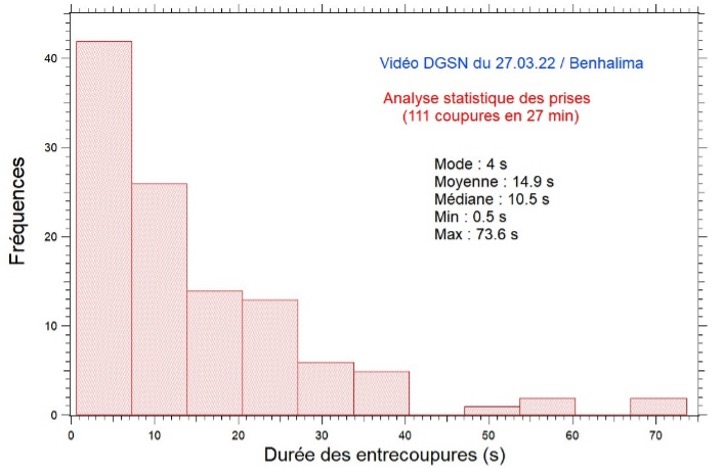
Let us now focus on the analysis of the structure of the images and their arrangements.
To verify whether the recording was continuous or not, the variation in background lighting conditions across all video frames should be examined. This is done by extracting each image using the ffmpeg software, after which it is converted from the RGB color space to the HSV one, and then broken down into three layers: Hue, Saturation and Value (lightness), as shown in Tables 1 and 2.
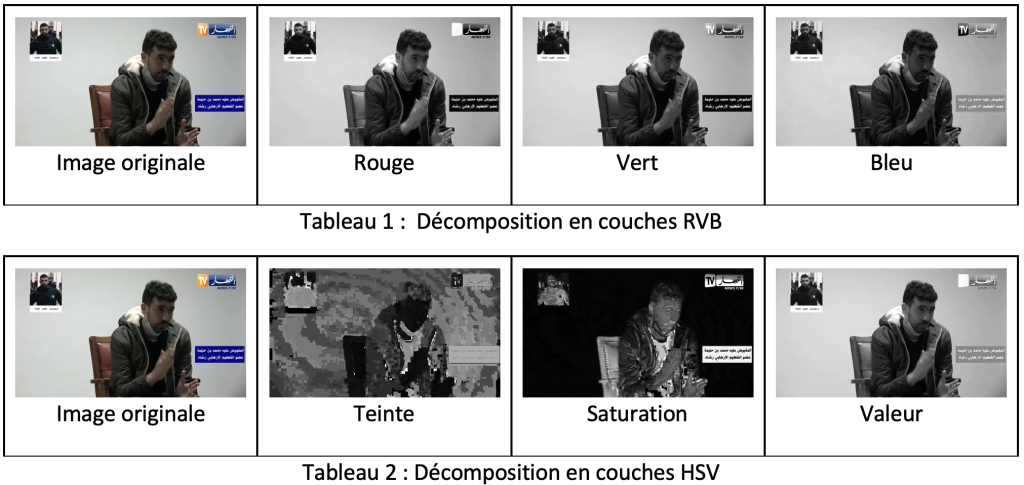
The resulting HSV layers for each frame were used to analyze the continuity of the Saturation and Backlight Value component of each frame of the video. A video recorded in a single session with no sudden changes in lighting conditions will not show jumps in Saturation or Value amplitudes between consecutive frames.
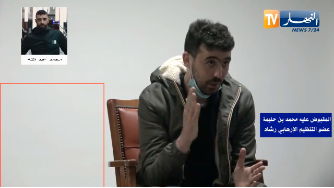
Figure 3a shows the variation of average background saturation with frame number (25 frames = 1 second). There are clearly jumps between two levels of background saturation. The histogram of background saturation amplitudes in Figure 3b reveals two clusters: cluster A with a saturation value between 4 and 6, and cluster B with a saturation value between 13 and 18. The calculation and representation of the same quantities with the HSV Value layer[16] (Figures 4a and 4b) confirms that the BMA video includes two recordings with two different lighting conditions, the two recordings being distinguishable by comparing the background saturation value to a saturation value of 10.

The presence of two recordings does not necessarily imply that two recording sessions took place at two different times, since recording the same scene, using two cameras with different calibrations (shutter speed, ISO speed or aperture), can produce two recordings that do not share the same background lighting conditions.
To determine the number of recording sessions, several images of each recording can be compared by visual inspection. As shown in Figure 5, six samples were taken. Images 1, 3 and 5 have a background saturation value greater than 10, while this value is less than 10 for images 2, 4 and 6. These two sets of samples are illustrated in Tables 3 and 4 respectively
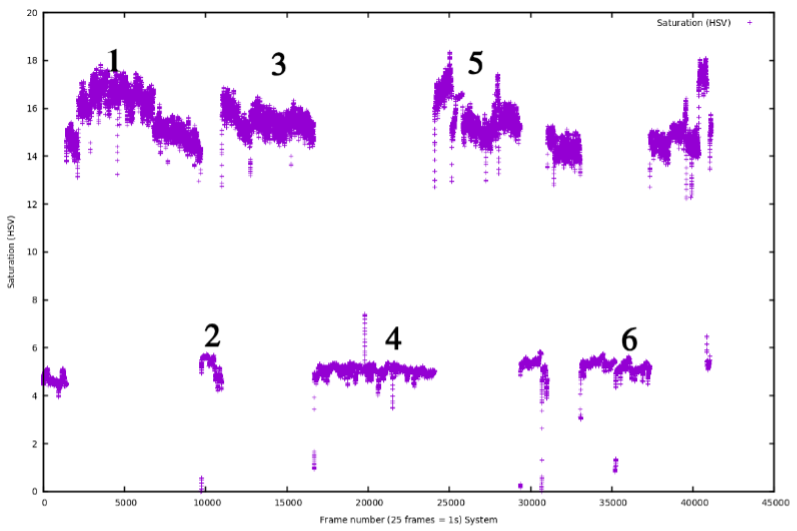

A close comparison between the images of the two identified sets of recordings reveals new unique differentiators to assess: 1) the position of the chair is not the same, the armchair serving as a benchmark for comparison, and 2) the opening of the jacket and the presence or absence of a white t-shirt under the black sweater. These differentiating factors are illustrated in Table 5. The position of the chair cannot prove the existence of a second recording session because it could be the result of a camera repositioning, but the opening of the jacket and the white t-shirt as well as the correlation with the background saturation value on all 111 cuts prove beyond doubt that two recording sessions were used to produce the video. This observation is also corroborated by the audio data. At timestamp 17’40”, BMA says he slept well, while at timestamp 24’19”, he says: ‘Today, Miloud [Mohamed Larbi Zitout’s brother] visited me [in the Spanish detention centre]’, i.e. he is talking on the day he was expelled from Spain.
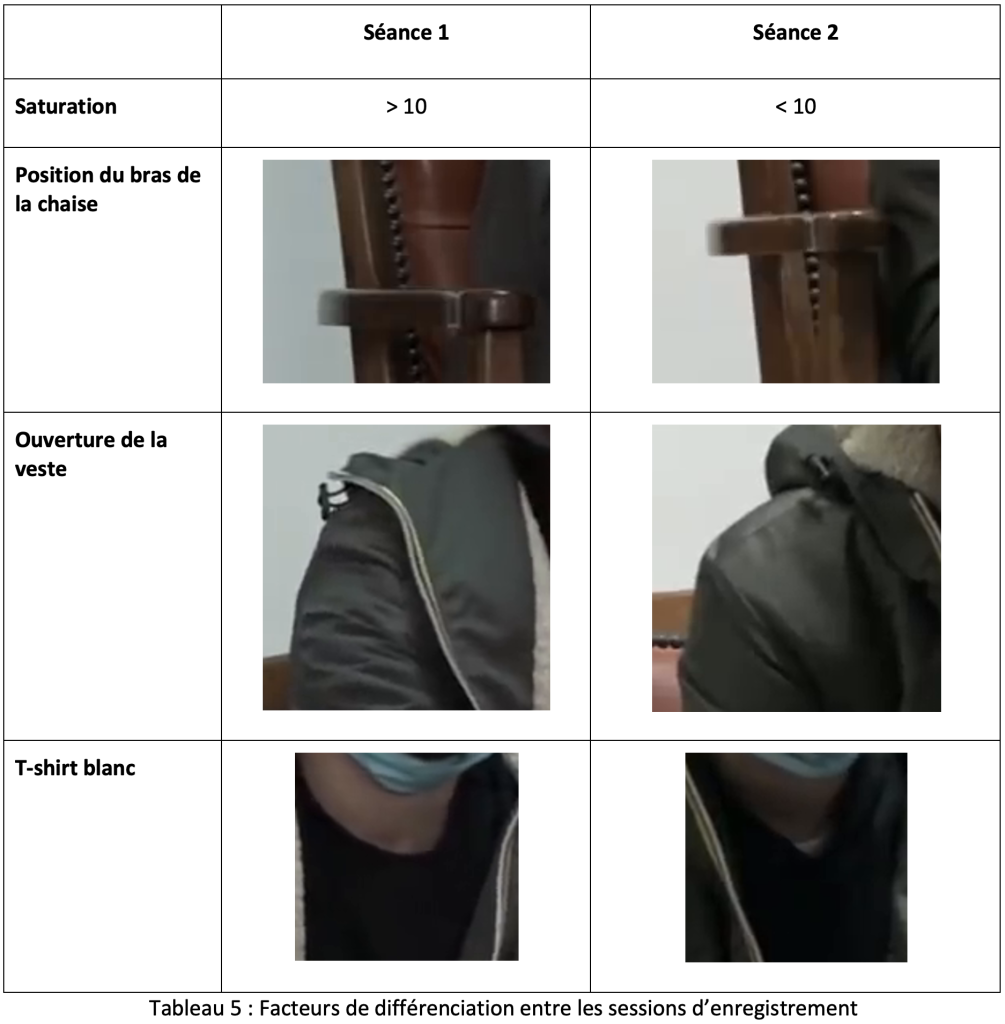
The per-image analysis above also allows to draw conclusions on the post-production of the video. Figures 3a and 4a clearly show that crosscutting was used. Images filmed in the first session were juxtaposed with images filmed in the second session, and vice versa, to suggest artificial thematic and temporal continuities. Audio-wise, we can also see this by the fact that at time stamp 17’40” BMA says that he slept well, whereas at time stamp 24’19” he is talking on the day of his expulsion, which reverses the actual chronological order. Finally, the collage of photos (of the people cited in the ‘confessions’) at the top left of the frame to make didactic propaganda further compromises the authenticity of the video and the judicial value one may ascribe to it.
The forensic analysis of the video shows that the willful semblance of BMA’s statements is a hoax. What appeared as BMA spontaneously ‘spilling the beans’ is the result of a scripted spectacle, fabricated with heavily chopped and manipulated audio-video material. This propaganda video has no authenticity, and it does constitute a judicial evidence against BMA. On the contrary, it is an indelible physical evidence of a crime committed against BMA.
3. A judicial disclosure or information warfare?
Let us recall that Mohamed Benhalima is a former army corporal, active in the hirak from its start in 2019. In its wake, he became a whistleblower denouncing corruption among senior Algerian military officials. He fled the country that same year after learning that he was on a list of soldiers to be arrested for their active participation in the hirak.
Since a judicial confession is the act of acknowledging misdemeanors or crimes, if the video distributed by the DGSN actually constituted a confession, BMA’s statements assembled therein would explain or at least relate to the misdemeanors or crimes that he allegedly had committed. However, the only footage where there is a semblance of a confession is in the part where he asks forgiveness from the head of the State, Tebboune. This passage, which lasts 1 min 50 s out of the 27 minutes and 57 seconds of the video, is at the end of the video (25’30”), to provide a denouement that closes the saga. Mediatized public confessions in dictatorships are known to conclude with an emotional display of shame to make the ritual of confession credible, as well as to validate the power of dictators through the trembling and tears of those who had once defied them.[17] Foucault thought that the main role of public confession is to discipline the subjects.[18]
However, even within this passage of repentance, the only precise facts that BMA incriminates himself with last 7 seconds, from 26’09” to 26’16”, when he states: ‘I made mistakes, I have insulted, and I hope that those I insulted or of whom I have spoken ill about will forgive me’. No investigation or exploration or request for clarification around these ‘mistakes’ or ‘insults’, presumably on the offenses or crimes relating to his activities as a whistleblower, is presented in the footage of the video broadcasted by the DGSN.
The video is therefore not a judicial confession because the rest of the video (26 out of 28 minutes) has nothing to do with BMA’s judicial situation. It is dedicated to political propaganda, to information warfare.
The messages conveyed by this info-war video are not the same for the multiple audiences it targets. For the hirak, the video delivers the message that a segment of the hirak abroad is allegedly manipulated and plagued by activists within and outside Rachad or Mohamed Abdellah association, who act as crooks with no political cause, hijacking PayPal funds here, falsifying documents there. Mohamed Larbi Zitout is allegedly a narcissistic YouTuber motivated only by money and buzz. The purpose of this info-war is obvious: to radicalize the political enemy (Rachad among others) so as to divide the hirak, to project an aura of invincibility to demoralize the hirak, to silence it, to discipline it, and to stifle and deter any protest. The hirakis have no salvation except in repenting to – and obeying – Tebboune and the generals lurking behind him.
The other no less important audience is that which identifies directly with BMA: soldiers, non-commissioned officers, and officers of the army as well as other security agencies. The message that the video sends them is that the army chiefs have long arms, and that they will reach any whistleblower who breaks the omerta on the corruption within it, wherever he hides in the world. Any whistleblower will end up confessing in public and throwing himself at their feet in repentance.
4. Benhalima’s video under international law ratified by Algeria
Given that the content of the video is essentially political, we are entitled to conclude that BMA’s interrogators and the scriptwriters, producers and director of the video were not judicial police officers carrying out a regular preliminary investigation, but officers the DGSI. The DGSN logo affixed to the video does not deceive anyone. The filmed ‘confessions’ that were extracted therein and their dissemination fall outside the legal framework.
BMA was forced to make the statements recorded in the video. However, the International Covenant on Civil and Political Rights, ratified by Algeria, stipulates in its article 14, 3g, that no one should ‘be compelled to testify against himself or to confess guilt’.
Moreover, the public broadcasting of confessions before a trial reduces the latter to a mere formality. After a suspect has made a confession on public television, what prosecutor will have the temerity not to charge him, what judge will venture not to convict him, even if he retracts his confession afterwards?[19] This seriously compromises the right to a fair trial enshrined in the same covenant, article 14, 1, which declares that ‘in the determination of any criminal charge against him, or of his rights and obligations in a suit at law, everyone shall be entitled to a fair and public hearing by a competent, independent and impartial tribunal established by law.’
On the other hand, the spooks of the DGSI have violated the principles of international law, which protects whistleblowers.[20] Article 19, 2, of the same covenant states that ‘everyone shall have the right to freedom of expression; this right shall include freedom to seek, receive and impart information and ideas of all kinds, regardless of frontiers, either orally, in writing or in print, in the form of art, or through any other media of his choice.’ In addition, Algeria ratified in 2004 the United Nations Convention against Corruption, which includes in its article 33 provisions relating to the protection of persons reporting corruption.
5. On necroculture as a conclusion
Contrary to what the media subservient to the military regime have reported, the video of the whistleblower BMA published by the DGSN is not a confession video. It is the video of a hostage. It is a ‘dahdouh-ation’, as popular humor has mocked it.
We showed here that BMA does not express himself freely in this video, and that his heavily chopped statements were swapped, cut, pasted, collated, edited, and fine-tuned to produce a show with a script written by the DGSI. The core of this confession show is meant to intimidate, divide and subdue the hirak, to invite hirakis to repent and submit to Tebboune and the generals hiding behind him, as well as to deter any new whistleblowing on corruption within the army and security forces.
As a political ventriloquist, General Djebbar Mhenna hacked BMA’s images and speech to communicate his threats, his dead and deadly ideas to us. In so doing, he gave us a glimpse of the necroculture that still permeates this security agency.
Faced with the extraordinary opportunity for a democratic transition opened up by the hirak, the elderly generals of our army, stuck in a bygone past, reject new ideas, evolution and change. They are blindly focused on dead ideas, addicted to compulsively repeating recipes that they know are counterproductive and worn out. This is what Moises Naim calls ideological necrophilia.[21]
Instead of taking one step into the future, they took two steps into the past, into political and media clampdown, the discourse of terrorism, police brutality, torture, mass political imprisonment, and TV confession shows on primetime 8 pm news hour from the 90s.
6. References
[1] For instance, « Diffusion imminente de graves aveux par le membre de l’organisation terroriste Rachad, Benhalima », L’Expression, 27 March 2022.
[2] APS, 27 March 2022.
[3] TSA, 27 March 2022.
[4] For instance, Ennahar and Echorouk headlines highlighted the ‘shocking’ nature of the ‘confession’, whereas al-Bilad and Sawt al-akhar’s headlines pointed up their ‘dangerous’ type. (27 March 2022).
[5] Direction Générale de la Sécurité Intérieure (General Directorate of Internal Security).
[6] Saul M. Kassin, ‘The Social Psychology of False Confessions’, Social Issues and Policy Review 9 (2015) pp. 25-51; Saul M. Kassin and Gisli H. Gudjonsson, ‘The Psychology of Confessions: A Review of the Literature and Issues’, Psychological Science in the Public Interest 5 (2004) pp. 33-67; Saul M. Kassin, ‘False Confessions: How Can Psychology So Basic Be So Counterintuitive?’, American Psychologist 72 (2017) pp. 951-964.
[7] Private communication.
[8] Départment du Renseignement et de la Sécurité, the former name of the DGSI.
[9] On 12 April 2001, at the show trial of the murder of Abdelkader Hachani, the accused, Fouad Boulemia, told the judge – in front of an astounded courtroom: ‘They tortured me badly, do you understand? Then General Toufik [Médiene] came, he said to me: ‘Ana Rabha’ [I am the Master], you will see what I am going to do with you. Either you accept to say that you killed Hachani and you will get fifteen years of prison, your parents will be able to visit you. Otherwise, I am going to take you to your mother’s place, and I am going to gut her in front of you. I am General Toufik, Rab Edzayer [the God of Algeria].’ ‘Otherwise I’ll make you spit out the milk you suckled. I am General Toufik, Rab Edzayer’, according to another account reported by the newspaper Le Jeune Indépendant. Testimony of Fouad Boulemia reported by Daikha Dridi, ‘Hachani Assassination Trial: Fouad Boulemia Sentenced to Death’, Algeria -Watch, April 16, 2001; I. D., ‘Convicted of the assassination of Hachani, Boulemia sentenced to death’, Le Jeune Indépendant, April 14, 2001; La Tribune, April 14, 2001.
[10] For example, Amnesty International, ‘Algeria: End prosecution of activists who exposed torture of a child in police custody’, 22 March 2022; Amnesty International, Algeria 2021 Report; Al Karama, ‘Algeria: the Special Rapporteur against Torture to Examine the case of Yasser Rouibah’, 31 August 2021; Al Karama, ‘Algeria-Spain: the UN Special Rapporteur on Torture Seized of the case of the Military Whistleblower Mohammed Abdellah’, 28 January 2022.
[11] youtube commentary by journalist Abdou Semmar of March 27, 2022.
[12] Magnus Fiskesjö , ‘The Return of the Show Trial: China’s Televised “Confessions”’, The Asia-Pacific Journal 15 (2018) 1-31; Janny HC Leung, ‘Publicity stunts, power play, and information warfare in mediatized public confessions’, Law and Humanities 11 (2017) pp. 82–101; Ergin Bulut and Basak Can, ‘Media, Affect, and Authoritarian Futures in “New Turkey:” Spectacular Confessions on Television in the Post-Coup Era’, Communication, Culture and Critique 00 (2020) 1–21; Bärbel Harju, ‘Too Much Information: Self-Monitoring and Confessional Culture’, in Florian Zappe and Andrew S. Gross (eds.), Surveillance, Society, and Culture, Peterlang , Berlin 2020, pp 59-81. To see also the articles in note 6 .
[13] G. Daniel Lassiter et al, ‘Videotaped interrogations and confessions: A simple change in camera perspective alters verdicts in simulated trials’, Journal of Applied Psychology 87 (2002) pp 867–874; G. Daniel Lassiter et al, ‘Evaluating Videotaped Confessions: Expertise Provides No Defence Against the Camera-Perspective Effect’, Psychological Science 18 (2007) p. 224–226; G. Daniel Lassiter et al, ‘The Potential for Bias in Videotaped Confessions’, Journal of Applied Social Psychology 22 (1992) 1838–1851; G. Daniel Lassiter et al, ‘Evidence of the camera perspective bias in authentic videotaped interrogations: Implications for emerging reform in the criminal justice system’, Legal and Criminological Psychology 14 (2009) pp. 157–170.
[14] Ibid.
[15] Ibid.
[16] By definition, the HSV saturation takes values between 0 and 1, but the software we used applies a mapping on a scale of 0 to 255.
[17] See footnote 12.
[18] Chloe Taylor, The Culture of Confession from Augustine to Foucault: A Genealogy of the ‘Confessing Animal’, Routledge, New York, 2008.
[19] See footnote 12.
[20] Dr Kafteranis, ‘The International Legal Framework on Whistle-Blowers: What More Should Be Done?’, Seattle Journal for Social Justice 19 (2021) p. 729-758.
[21] Moises Naim, ‘What is Ideological Necrophilia’, The Atlantic 24 February 2016; Yovani Chavez, ‘Ideological Necrophilia’, DKI APCSS Security Nexus, 2016.





